Exploring Convergence and Divergence in International HRM Practices
VerifiedAdded on 2023/06/15
|8
|2091
|379
Essay
AI Summary
This essay provides a detailed analysis of convergence and divergence in International Human Resource Management (IHRM), focusing on examples from India and the UK. It discusses how convergence, the tendency for group members to be alike, can foster company culture and unity, while divergence, the tendency to be less alike, can lead to challenges. The essay examines how these concepts manifest in the workplace, considering factors such as work ethics, lifestyle, and influence. It argues that while convergence can promote unity and idea generation, divergence can foster innovation and competitive advantage. The analysis suggests that companies are increasingly adopting divergence strategies to empower employees and achieve success in both personal and professional spheres. The essay concludes that a balanced approach, utilizing both convergence and divergence, is crucial for organizations and individuals to thrive in the competitive global market, particularly in diverse cultural contexts like India and the UK. Desklib offers this solution and many more to aid students in their academic journey.
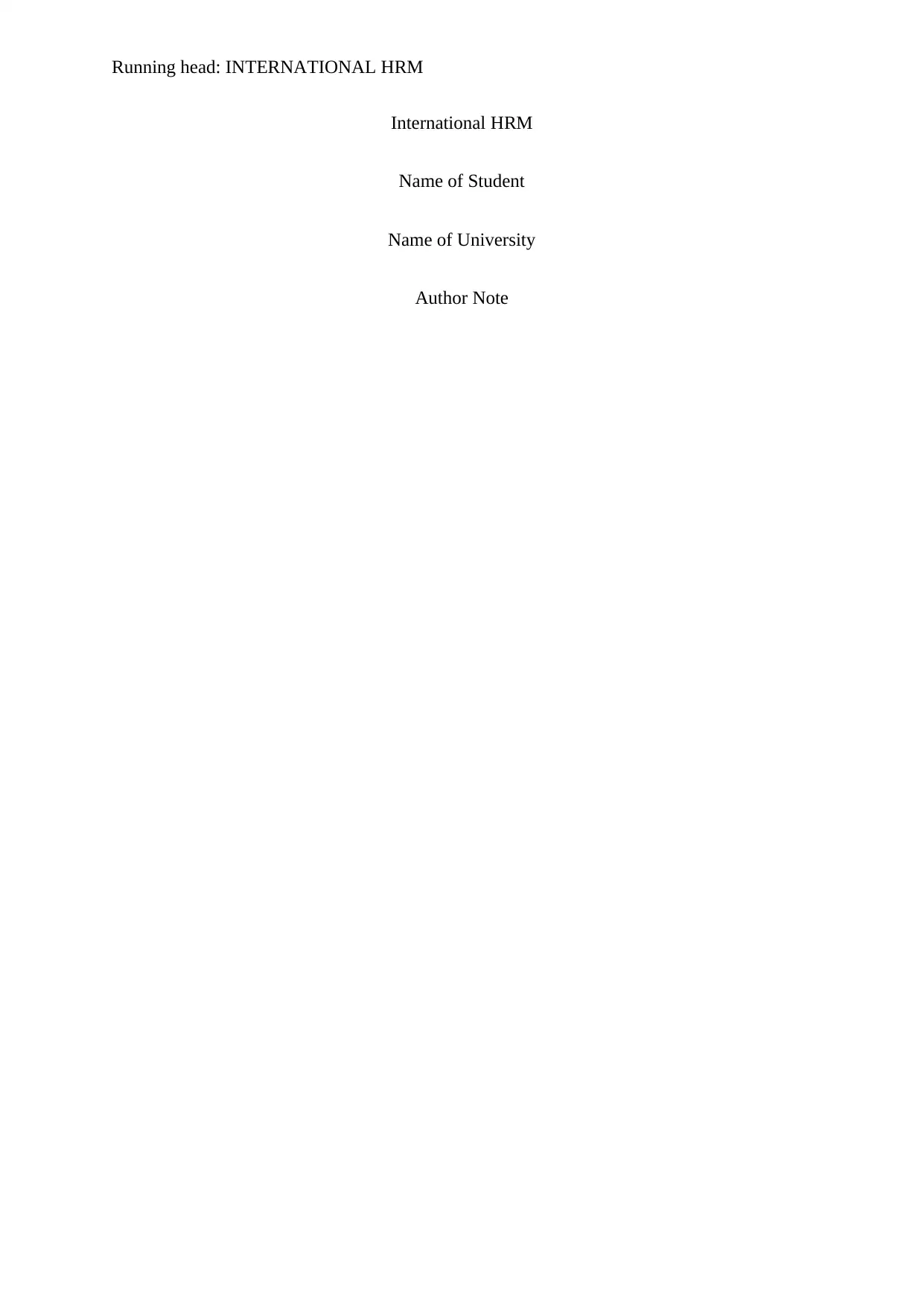
Running head: INTERNATIONAL HRM
International HRM
Name of Student
Name of University
Author Note
International HRM
Name of Student
Name of University
Author Note
Paraphrase This Document
Need a fresh take? Get an instant paraphrase of this document with our AI Paraphraser
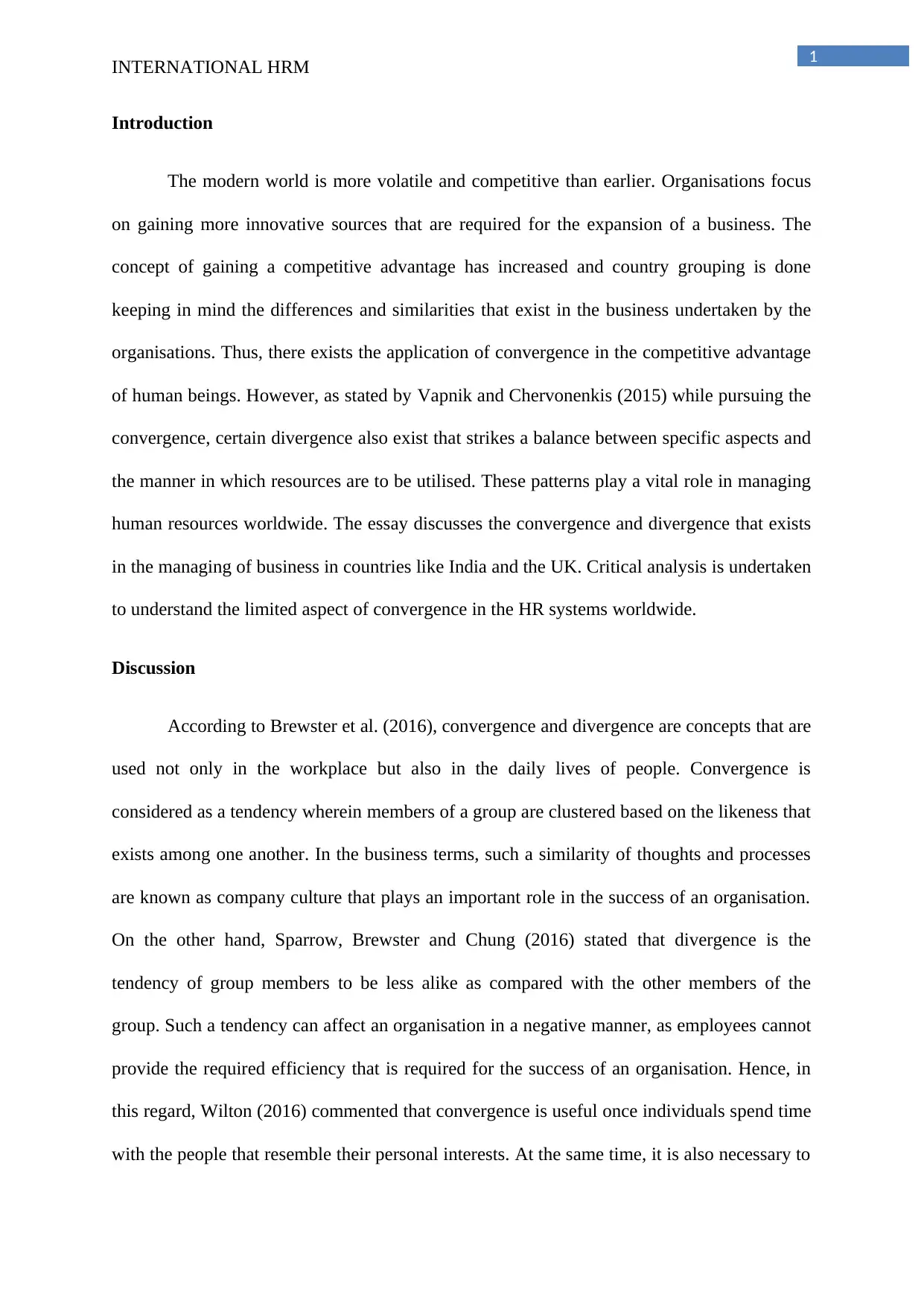
1
INTERNATIONAL HRM
Introduction
The modern world is more volatile and competitive than earlier. Organisations focus
on gaining more innovative sources that are required for the expansion of a business. The
concept of gaining a competitive advantage has increased and country grouping is done
keeping in mind the differences and similarities that exist in the business undertaken by the
organisations. Thus, there exists the application of convergence in the competitive advantage
of human beings. However, as stated by Vapnik and Chervonenkis (2015) while pursuing the
convergence, certain divergence also exist that strikes a balance between specific aspects and
the manner in which resources are to be utilised. These patterns play a vital role in managing
human resources worldwide. The essay discusses the convergence and divergence that exists
in the managing of business in countries like India and the UK. Critical analysis is undertaken
to understand the limited aspect of convergence in the HR systems worldwide.
Discussion
According to Brewster et al. (2016), convergence and divergence are concepts that are
used not only in the workplace but also in the daily lives of people. Convergence is
considered as a tendency wherein members of a group are clustered based on the likeness that
exists among one another. In the business terms, such a similarity of thoughts and processes
are known as company culture that plays an important role in the success of an organisation.
On the other hand, Sparrow, Brewster and Chung (2016) stated that divergence is the
tendency of group members to be less alike as compared with the other members of the
group. Such a tendency can affect an organisation in a negative manner, as employees cannot
provide the required efficiency that is required for the success of an organisation. Hence, in
this regard, Wilton (2016) commented that convergence is useful once individuals spend time
with the people that resemble their personal interests. At the same time, it is also necessary to
INTERNATIONAL HRM
Introduction
The modern world is more volatile and competitive than earlier. Organisations focus
on gaining more innovative sources that are required for the expansion of a business. The
concept of gaining a competitive advantage has increased and country grouping is done
keeping in mind the differences and similarities that exist in the business undertaken by the
organisations. Thus, there exists the application of convergence in the competitive advantage
of human beings. However, as stated by Vapnik and Chervonenkis (2015) while pursuing the
convergence, certain divergence also exist that strikes a balance between specific aspects and
the manner in which resources are to be utilised. These patterns play a vital role in managing
human resources worldwide. The essay discusses the convergence and divergence that exists
in the managing of business in countries like India and the UK. Critical analysis is undertaken
to understand the limited aspect of convergence in the HR systems worldwide.
Discussion
According to Brewster et al. (2016), convergence and divergence are concepts that are
used not only in the workplace but also in the daily lives of people. Convergence is
considered as a tendency wherein members of a group are clustered based on the likeness that
exists among one another. In the business terms, such a similarity of thoughts and processes
are known as company culture that plays an important role in the success of an organisation.
On the other hand, Sparrow, Brewster and Chung (2016) stated that divergence is the
tendency of group members to be less alike as compared with the other members of the
group. Such a tendency can affect an organisation in a negative manner, as employees cannot
provide the required efficiency that is required for the success of an organisation. Hence, in
this regard, Wilton (2016) commented that convergence is useful once individuals spend time
with the people that resemble their personal interests. At the same time, it is also necessary to
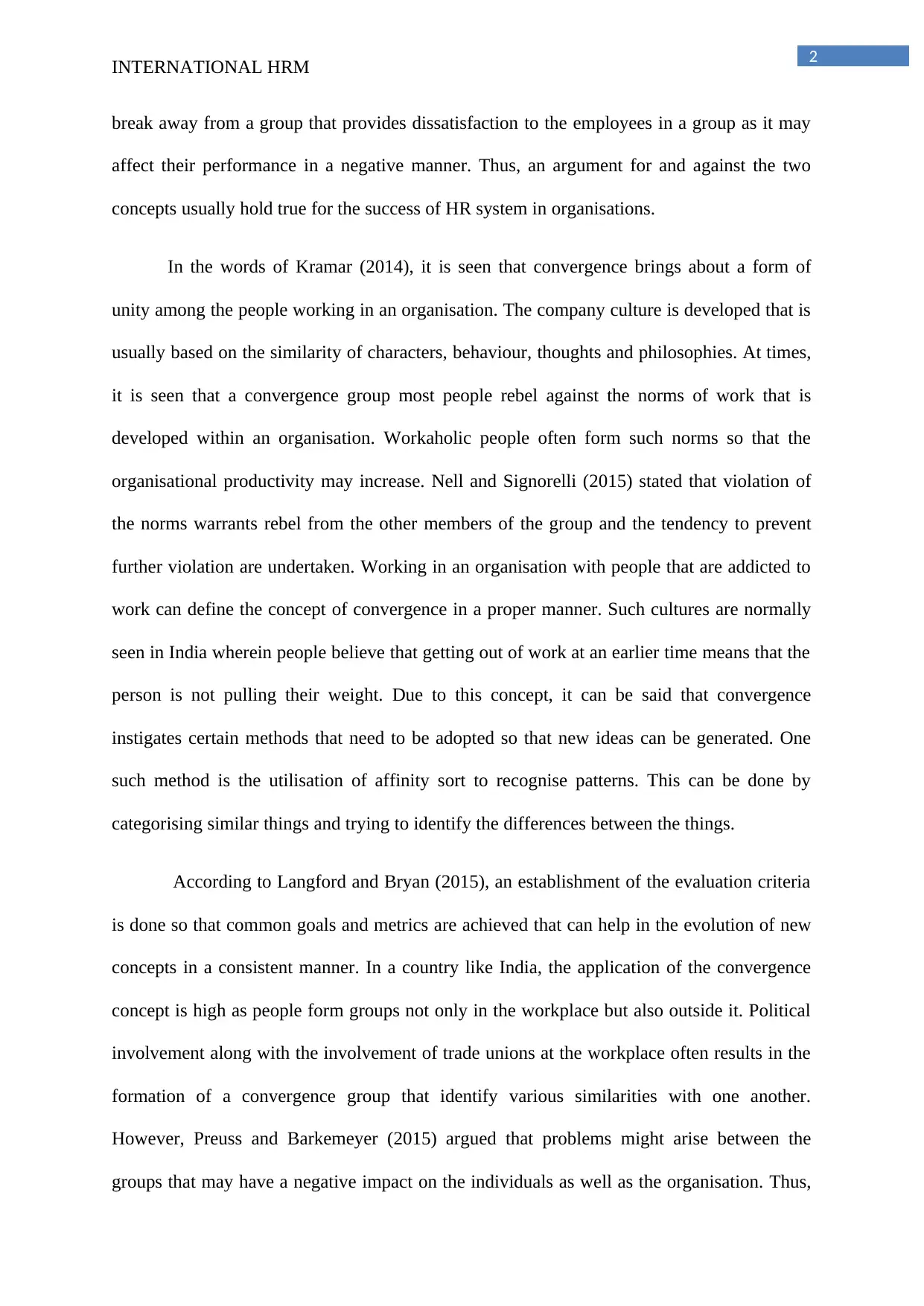
2
INTERNATIONAL HRM
break away from a group that provides dissatisfaction to the employees in a group as it may
affect their performance in a negative manner. Thus, an argument for and against the two
concepts usually hold true for the success of HR system in organisations.
In the words of Kramar (2014), it is seen that convergence brings about a form of
unity among the people working in an organisation. The company culture is developed that is
usually based on the similarity of characters, behaviour, thoughts and philosophies. At times,
it is seen that a convergence group most people rebel against the norms of work that is
developed within an organisation. Workaholic people often form such norms so that the
organisational productivity may increase. Nell and Signorelli (2015) stated that violation of
the norms warrants rebel from the other members of the group and the tendency to prevent
further violation are undertaken. Working in an organisation with people that are addicted to
work can define the concept of convergence in a proper manner. Such cultures are normally
seen in India wherein people believe that getting out of work at an earlier time means that the
person is not pulling their weight. Due to this concept, it can be said that convergence
instigates certain methods that need to be adopted so that new ideas can be generated. One
such method is the utilisation of affinity sort to recognise patterns. This can be done by
categorising similar things and trying to identify the differences between the things.
According to Langford and Bryan (2015), an establishment of the evaluation criteria
is done so that common goals and metrics are achieved that can help in the evolution of new
concepts in a consistent manner. In a country like India, the application of the convergence
concept is high as people form groups not only in the workplace but also outside it. Political
involvement along with the involvement of trade unions at the workplace often results in the
formation of a convergence group that identify various similarities with one another.
However, Preuss and Barkemeyer (2015) argued that problems might arise between the
groups that may have a negative impact on the individuals as well as the organisation. Thus,
INTERNATIONAL HRM
break away from a group that provides dissatisfaction to the employees in a group as it may
affect their performance in a negative manner. Thus, an argument for and against the two
concepts usually hold true for the success of HR system in organisations.
In the words of Kramar (2014), it is seen that convergence brings about a form of
unity among the people working in an organisation. The company culture is developed that is
usually based on the similarity of characters, behaviour, thoughts and philosophies. At times,
it is seen that a convergence group most people rebel against the norms of work that is
developed within an organisation. Workaholic people often form such norms so that the
organisational productivity may increase. Nell and Signorelli (2015) stated that violation of
the norms warrants rebel from the other members of the group and the tendency to prevent
further violation are undertaken. Working in an organisation with people that are addicted to
work can define the concept of convergence in a proper manner. Such cultures are normally
seen in India wherein people believe that getting out of work at an earlier time means that the
person is not pulling their weight. Due to this concept, it can be said that convergence
instigates certain methods that need to be adopted so that new ideas can be generated. One
such method is the utilisation of affinity sort to recognise patterns. This can be done by
categorising similar things and trying to identify the differences between the things.
According to Langford and Bryan (2015), an establishment of the evaluation criteria
is done so that common goals and metrics are achieved that can help in the evolution of new
concepts in a consistent manner. In a country like India, the application of the convergence
concept is high as people form groups not only in the workplace but also outside it. Political
involvement along with the involvement of trade unions at the workplace often results in the
formation of a convergence group that identify various similarities with one another.
However, Preuss and Barkemeyer (2015) argued that problems might arise between the
groups that may have a negative impact on the individuals as well as the organisation. Thus,
⊘ This is a preview!⊘
Do you want full access?
Subscribe today to unlock all pages.

Trusted by 1+ million students worldwide
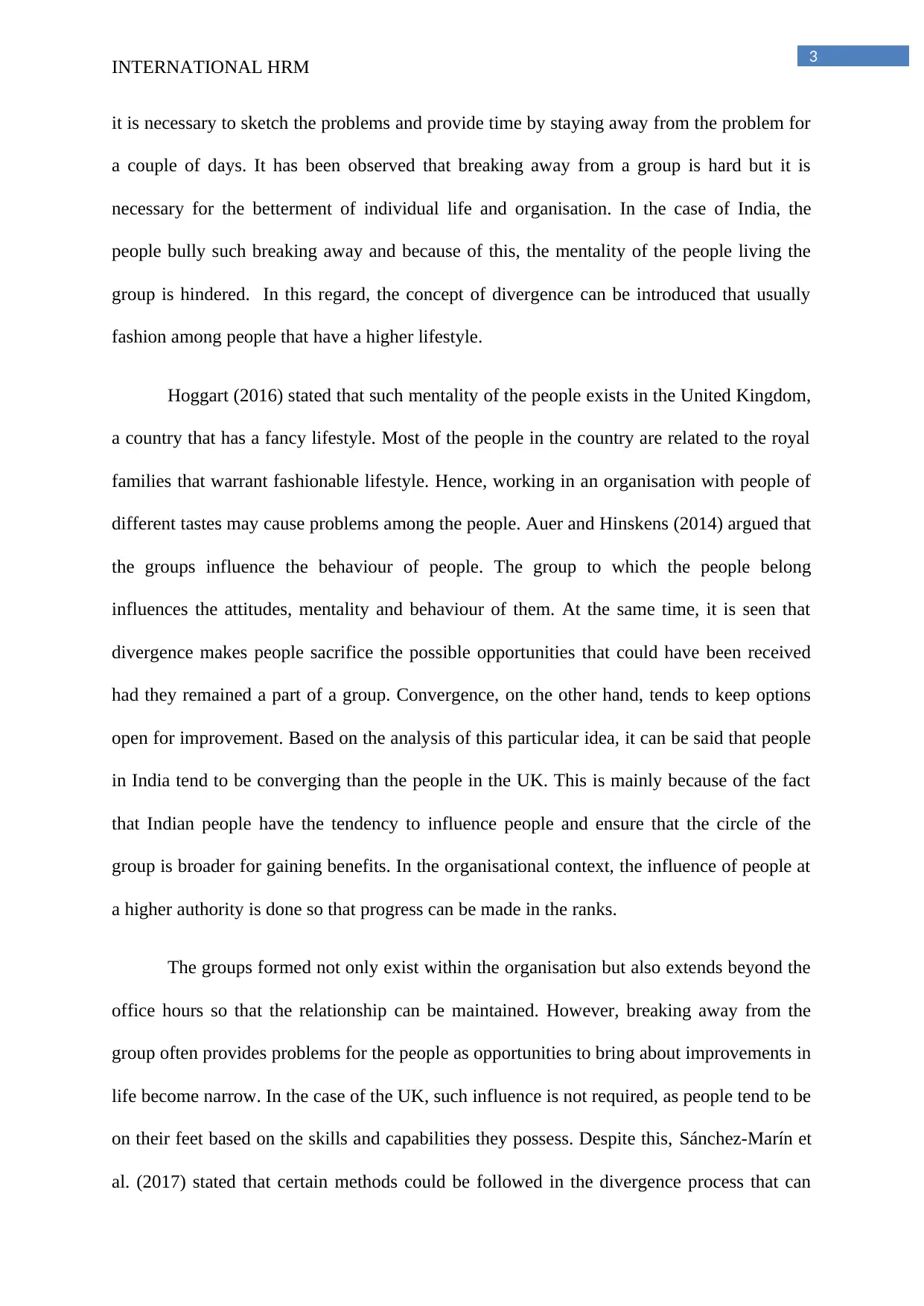
3
INTERNATIONAL HRM
it is necessary to sketch the problems and provide time by staying away from the problem for
a couple of days. It has been observed that breaking away from a group is hard but it is
necessary for the betterment of individual life and organisation. In the case of India, the
people bully such breaking away and because of this, the mentality of the people living the
group is hindered. In this regard, the concept of divergence can be introduced that usually
fashion among people that have a higher lifestyle.
Hoggart (2016) stated that such mentality of the people exists in the United Kingdom,
a country that has a fancy lifestyle. Most of the people in the country are related to the royal
families that warrant fashionable lifestyle. Hence, working in an organisation with people of
different tastes may cause problems among the people. Auer and Hinskens (2014) argued that
the groups influence the behaviour of people. The group to which the people belong
influences the attitudes, mentality and behaviour of them. At the same time, it is seen that
divergence makes people sacrifice the possible opportunities that could have been received
had they remained a part of a group. Convergence, on the other hand, tends to keep options
open for improvement. Based on the analysis of this particular idea, it can be said that people
in India tend to be converging than the people in the UK. This is mainly because of the fact
that Indian people have the tendency to influence people and ensure that the circle of the
group is broader for gaining benefits. In the organisational context, the influence of people at
a higher authority is done so that progress can be made in the ranks.
The groups formed not only exist within the organisation but also extends beyond the
office hours so that the relationship can be maintained. However, breaking away from the
group often provides problems for the people as opportunities to bring about improvements in
life become narrow. In the case of the UK, such influence is not required, as people tend to be
on their feet based on the skills and capabilities they possess. Despite this, Sánchez-Marín et
al. (2017) stated that certain methods could be followed in the divergence process that can
INTERNATIONAL HRM
it is necessary to sketch the problems and provide time by staying away from the problem for
a couple of days. It has been observed that breaking away from a group is hard but it is
necessary for the betterment of individual life and organisation. In the case of India, the
people bully such breaking away and because of this, the mentality of the people living the
group is hindered. In this regard, the concept of divergence can be introduced that usually
fashion among people that have a higher lifestyle.
Hoggart (2016) stated that such mentality of the people exists in the United Kingdom,
a country that has a fancy lifestyle. Most of the people in the country are related to the royal
families that warrant fashionable lifestyle. Hence, working in an organisation with people of
different tastes may cause problems among the people. Auer and Hinskens (2014) argued that
the groups influence the behaviour of people. The group to which the people belong
influences the attitudes, mentality and behaviour of them. At the same time, it is seen that
divergence makes people sacrifice the possible opportunities that could have been received
had they remained a part of a group. Convergence, on the other hand, tends to keep options
open for improvement. Based on the analysis of this particular idea, it can be said that people
in India tend to be converging than the people in the UK. This is mainly because of the fact
that Indian people have the tendency to influence people and ensure that the circle of the
group is broader for gaining benefits. In the organisational context, the influence of people at
a higher authority is done so that progress can be made in the ranks.
The groups formed not only exist within the organisation but also extends beyond the
office hours so that the relationship can be maintained. However, breaking away from the
group often provides problems for the people as opportunities to bring about improvements in
life become narrow. In the case of the UK, such influence is not required, as people tend to be
on their feet based on the skills and capabilities they possess. Despite this, Sánchez-Marín et
al. (2017) stated that certain methods could be followed in the divergence process that can
Paraphrase This Document
Need a fresh take? Get an instant paraphrase of this document with our AI Paraphraser
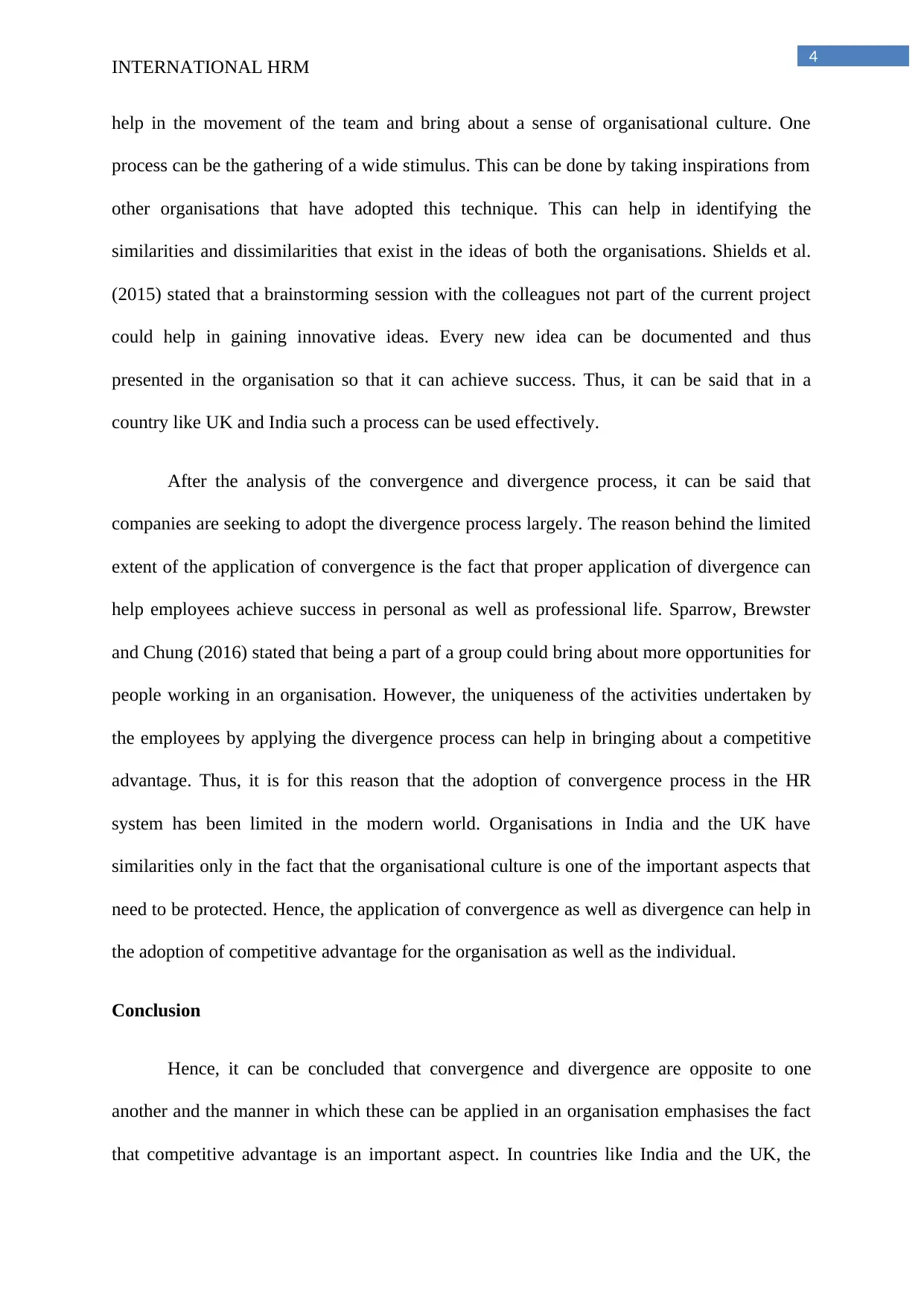
4
INTERNATIONAL HRM
help in the movement of the team and bring about a sense of organisational culture. One
process can be the gathering of a wide stimulus. This can be done by taking inspirations from
other organisations that have adopted this technique. This can help in identifying the
similarities and dissimilarities that exist in the ideas of both the organisations. Shields et al.
(2015) stated that a brainstorming session with the colleagues not part of the current project
could help in gaining innovative ideas. Every new idea can be documented and thus
presented in the organisation so that it can achieve success. Thus, it can be said that in a
country like UK and India such a process can be used effectively.
After the analysis of the convergence and divergence process, it can be said that
companies are seeking to adopt the divergence process largely. The reason behind the limited
extent of the application of convergence is the fact that proper application of divergence can
help employees achieve success in personal as well as professional life. Sparrow, Brewster
and Chung (2016) stated that being a part of a group could bring about more opportunities for
people working in an organisation. However, the uniqueness of the activities undertaken by
the employees by applying the divergence process can help in bringing about a competitive
advantage. Thus, it is for this reason that the adoption of convergence process in the HR
system has been limited in the modern world. Organisations in India and the UK have
similarities only in the fact that the organisational culture is one of the important aspects that
need to be protected. Hence, the application of convergence as well as divergence can help in
the adoption of competitive advantage for the organisation as well as the individual.
Conclusion
Hence, it can be concluded that convergence and divergence are opposite to one
another and the manner in which these can be applied in an organisation emphasises the fact
that competitive advantage is an important aspect. In countries like India and the UK, the
INTERNATIONAL HRM
help in the movement of the team and bring about a sense of organisational culture. One
process can be the gathering of a wide stimulus. This can be done by taking inspirations from
other organisations that have adopted this technique. This can help in identifying the
similarities and dissimilarities that exist in the ideas of both the organisations. Shields et al.
(2015) stated that a brainstorming session with the colleagues not part of the current project
could help in gaining innovative ideas. Every new idea can be documented and thus
presented in the organisation so that it can achieve success. Thus, it can be said that in a
country like UK and India such a process can be used effectively.
After the analysis of the convergence and divergence process, it can be said that
companies are seeking to adopt the divergence process largely. The reason behind the limited
extent of the application of convergence is the fact that proper application of divergence can
help employees achieve success in personal as well as professional life. Sparrow, Brewster
and Chung (2016) stated that being a part of a group could bring about more opportunities for
people working in an organisation. However, the uniqueness of the activities undertaken by
the employees by applying the divergence process can help in bringing about a competitive
advantage. Thus, it is for this reason that the adoption of convergence process in the HR
system has been limited in the modern world. Organisations in India and the UK have
similarities only in the fact that the organisational culture is one of the important aspects that
need to be protected. Hence, the application of convergence as well as divergence can help in
the adoption of competitive advantage for the organisation as well as the individual.
Conclusion
Hence, it can be concluded that convergence and divergence are opposite to one
another and the manner in which these can be applied in an organisation emphasises the fact
that competitive advantage is an important aspect. In countries like India and the UK, the
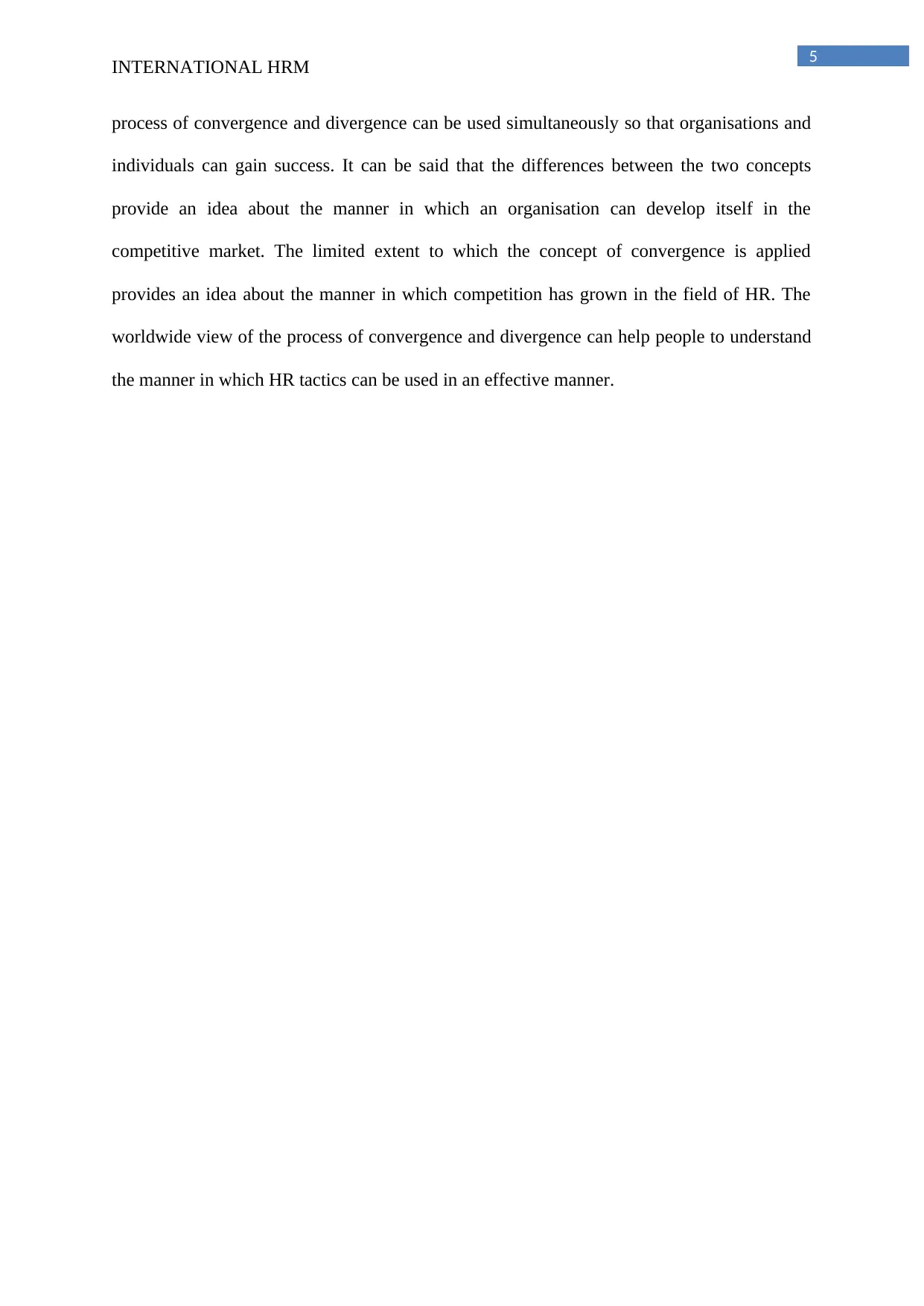
5
INTERNATIONAL HRM
process of convergence and divergence can be used simultaneously so that organisations and
individuals can gain success. It can be said that the differences between the two concepts
provide an idea about the manner in which an organisation can develop itself in the
competitive market. The limited extent to which the concept of convergence is applied
provides an idea about the manner in which competition has grown in the field of HR. The
worldwide view of the process of convergence and divergence can help people to understand
the manner in which HR tactics can be used in an effective manner.
INTERNATIONAL HRM
process of convergence and divergence can be used simultaneously so that organisations and
individuals can gain success. It can be said that the differences between the two concepts
provide an idea about the manner in which an organisation can develop itself in the
competitive market. The limited extent to which the concept of convergence is applied
provides an idea about the manner in which competition has grown in the field of HR. The
worldwide view of the process of convergence and divergence can help people to understand
the manner in which HR tactics can be used in an effective manner.
⊘ This is a preview!⊘
Do you want full access?
Subscribe today to unlock all pages.

Trusted by 1+ million students worldwide
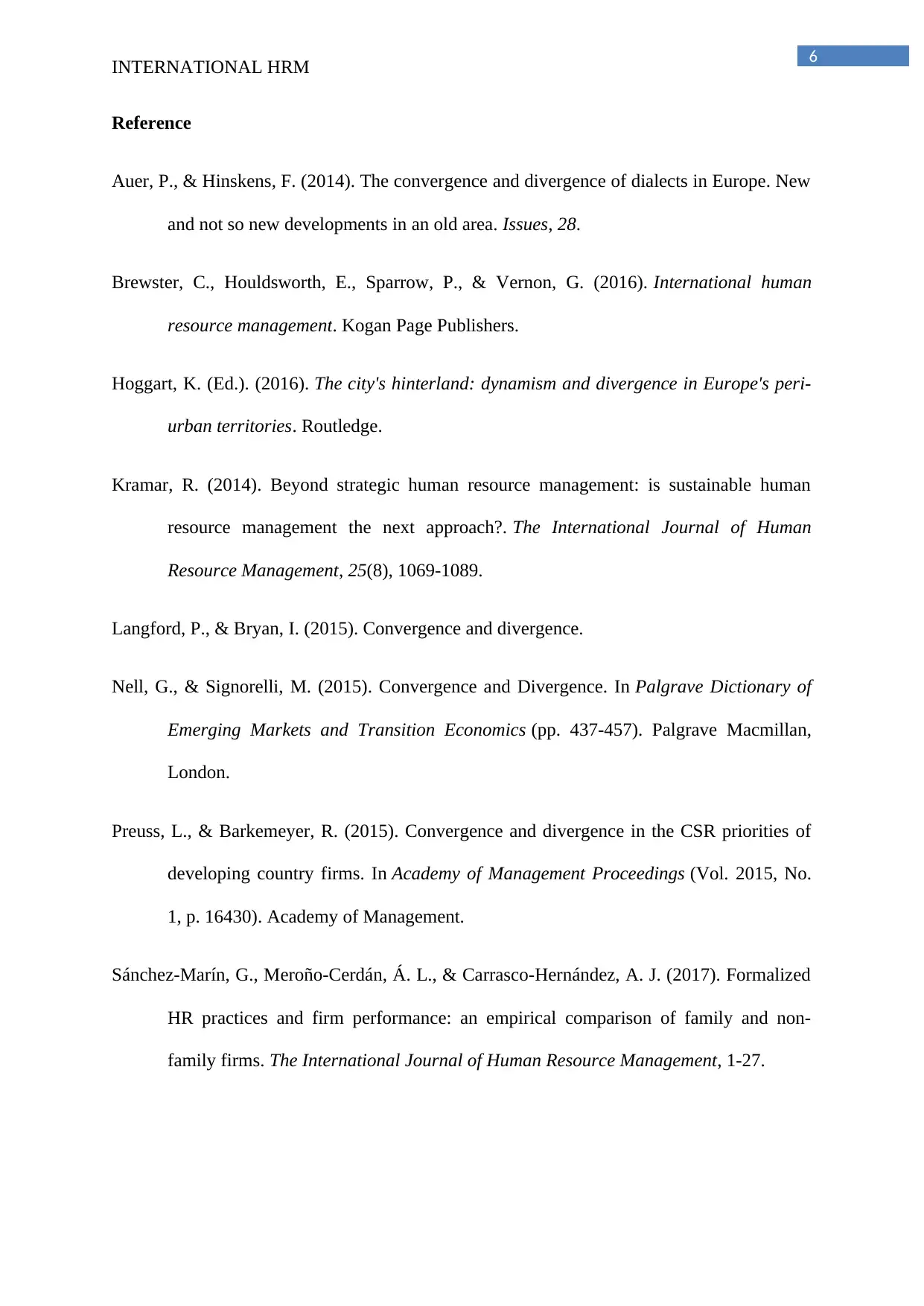
6
INTERNATIONAL HRM
Reference
Auer, P., & Hinskens, F. (2014). The convergence and divergence of dialects in Europe. New
and not so new developments in an old area. Issues, 28.
Brewster, C., Houldsworth, E., Sparrow, P., & Vernon, G. (2016). International human
resource management. Kogan Page Publishers.
Hoggart, K. (Ed.). (2016). The city's hinterland: dynamism and divergence in Europe's peri-
urban territories. Routledge.
Kramar, R. (2014). Beyond strategic human resource management: is sustainable human
resource management the next approach?. The International Journal of Human
Resource Management, 25(8), 1069-1089.
Langford, P., & Bryan, I. (2015). Convergence and divergence.
Nell, G., & Signorelli, M. (2015). Convergence and Divergence. In Palgrave Dictionary of
Emerging Markets and Transition Economics (pp. 437-457). Palgrave Macmillan,
London.
Preuss, L., & Barkemeyer, R. (2015). Convergence and divergence in the CSR priorities of
developing country firms. In Academy of Management Proceedings (Vol. 2015, No.
1, p. 16430). Academy of Management.
Sánchez-Marín, G., Meroño-Cerdán, Á. L., & Carrasco-Hernández, A. J. (2017). Formalized
HR practices and firm performance: an empirical comparison of family and non-
family firms. The International Journal of Human Resource Management, 1-27.
INTERNATIONAL HRM
Reference
Auer, P., & Hinskens, F. (2014). The convergence and divergence of dialects in Europe. New
and not so new developments in an old area. Issues, 28.
Brewster, C., Houldsworth, E., Sparrow, P., & Vernon, G. (2016). International human
resource management. Kogan Page Publishers.
Hoggart, K. (Ed.). (2016). The city's hinterland: dynamism and divergence in Europe's peri-
urban territories. Routledge.
Kramar, R. (2014). Beyond strategic human resource management: is sustainable human
resource management the next approach?. The International Journal of Human
Resource Management, 25(8), 1069-1089.
Langford, P., & Bryan, I. (2015). Convergence and divergence.
Nell, G., & Signorelli, M. (2015). Convergence and Divergence. In Palgrave Dictionary of
Emerging Markets and Transition Economics (pp. 437-457). Palgrave Macmillan,
London.
Preuss, L., & Barkemeyer, R. (2015). Convergence and divergence in the CSR priorities of
developing country firms. In Academy of Management Proceedings (Vol. 2015, No.
1, p. 16430). Academy of Management.
Sánchez-Marín, G., Meroño-Cerdán, Á. L., & Carrasco-Hernández, A. J. (2017). Formalized
HR practices and firm performance: an empirical comparison of family and non-
family firms. The International Journal of Human Resource Management, 1-27.
Paraphrase This Document
Need a fresh take? Get an instant paraphrase of this document with our AI Paraphraser
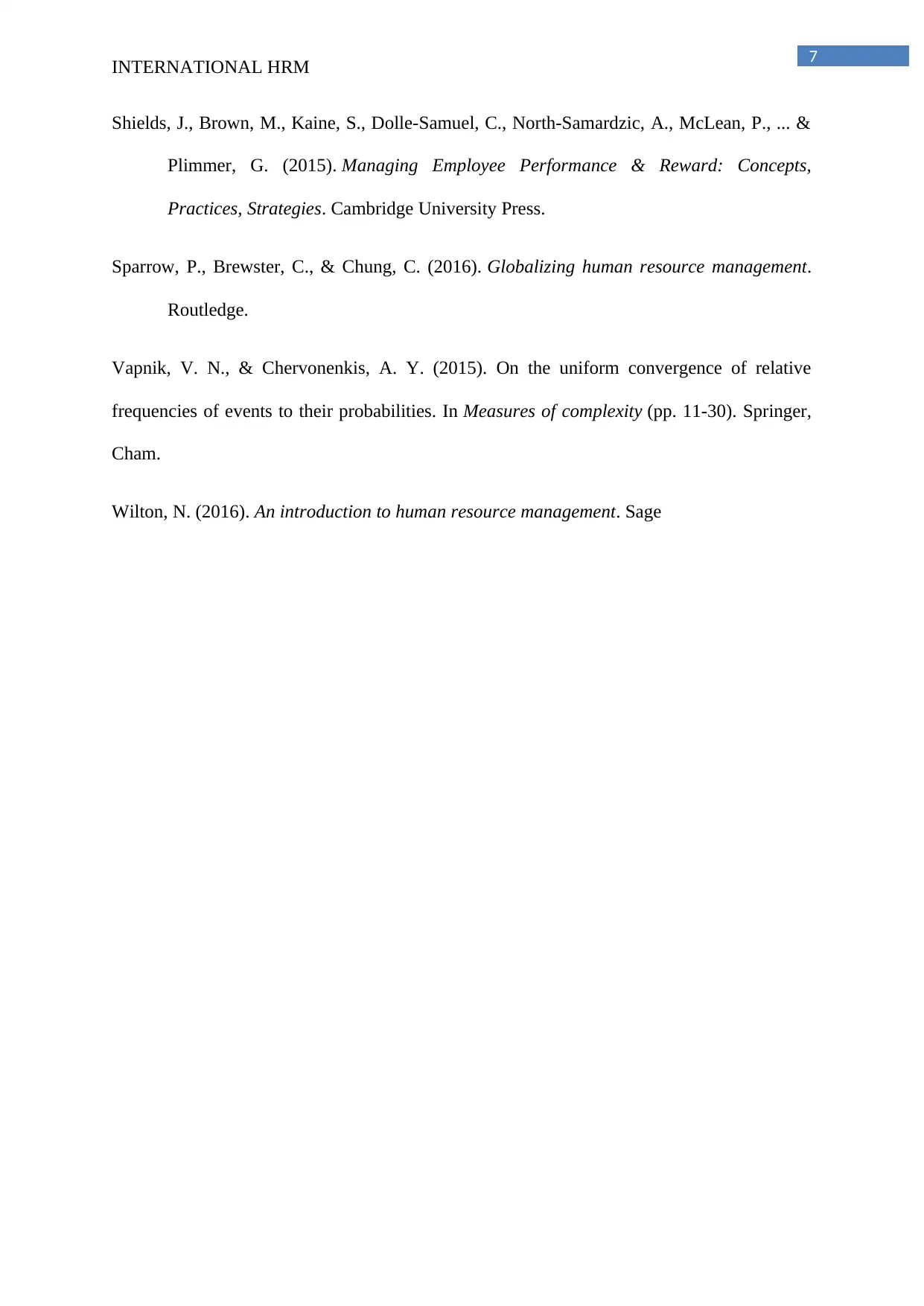
7
INTERNATIONAL HRM
Shields, J., Brown, M., Kaine, S., Dolle-Samuel, C., North-Samardzic, A., McLean, P., ... &
Plimmer, G. (2015). Managing Employee Performance & Reward: Concepts,
Practices, Strategies. Cambridge University Press.
Sparrow, P., Brewster, C., & Chung, C. (2016). Globalizing human resource management.
Routledge.
Vapnik, V. N., & Chervonenkis, A. Y. (2015). On the uniform convergence of relative
frequencies of events to their probabilities. In Measures of complexity (pp. 11-30). Springer,
Cham.
Wilton, N. (2016). An introduction to human resource management. Sage
INTERNATIONAL HRM
Shields, J., Brown, M., Kaine, S., Dolle-Samuel, C., North-Samardzic, A., McLean, P., ... &
Plimmer, G. (2015). Managing Employee Performance & Reward: Concepts,
Practices, Strategies. Cambridge University Press.
Sparrow, P., Brewster, C., & Chung, C. (2016). Globalizing human resource management.
Routledge.
Vapnik, V. N., & Chervonenkis, A. Y. (2015). On the uniform convergence of relative
frequencies of events to their probabilities. In Measures of complexity (pp. 11-30). Springer,
Cham.
Wilton, N. (2016). An introduction to human resource management. Sage
1 out of 8
Related Documents
Your All-in-One AI-Powered Toolkit for Academic Success.
+13062052269
info@desklib.com
Available 24*7 on WhatsApp / Email
![[object Object]](/_next/static/media/star-bottom.7253800d.svg)
Unlock your academic potential
Copyright © 2020–2025 A2Z Services. All Rights Reserved. Developed and managed by ZUCOL.





